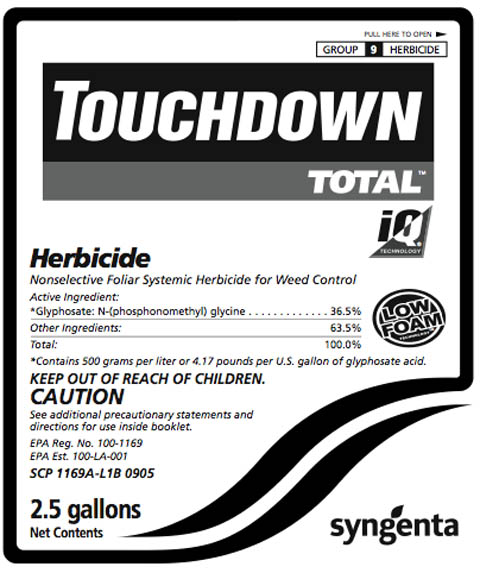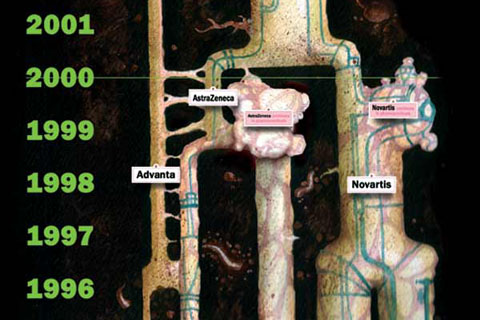SUBJECT: SYNGENTA PESTICIDE USE IN WAIMEA
SOURCE: JERI DI PIETRO ofstone@aol.com
POSTED: 12 JANUARY 2007 - 2:00pm HST
Report released: Syngenta incident at Waimea school

current head of the Syngenta family tree (click on image for whole illustration) corporatewatch.org
by Jeri Di Pietro & Mickey on on 11 January 2007 After days of spraying and Kona (southerly) winds blowing the spray into several classrooms... and after several days of Syngenta denying that they were spraying their checkerboard of open air GMO test fields at all... and thanks to the teachers union in Honolulu... the Waimea Canyon school was closed for four days for cleaning. This action came only after two weeks of complaints and headaches, when a huge puff of spray visibly blew into a couple of classrooms and sent keiki from ages 7 to 13 to the health office. Many adult staff had multiple reactions. The chemical 'Touchdown' was not the only spray applied. The chemical 'Eradicaine' seems to have been sprayed, and blown into the school as well. Exposure to this chemical has been shown to cause illness in humans. 40 to 50 kids were being treated in the Library (the only building with A/C). A few of the students fainted. Most think it was not the flu or the 'Stinkweed'. Aloha from Kaua`i, home of open air GMO field test. Check out www.hawaiiseed.org
[Editor's Note: If the people of Kauai realized that they and their children were lab rats in a gigantic experiment with no known outcome, we might see a different response to events like the incident at Waimea School. The County, the State Department of Agriculture, the Department of Education, and the private sector have looked the other way and ignored the danger to our children.] |
SUBJECT: SYNGENTA PESTICIDE USE IN WAIMEA
SOURCE: JERI DI PIETRO ofstone@aol.com
POSTED: 24 NOVEMBER 2006 - 11:00am HST
GMO fields near Waimea Elementary School

Not for human consumption In
case you haven't heard, the Garden Island has run three front page
stories on students at Waimea school getting physically ill. Syngenta
responded in regard to their GMO test crops on the other side of the
fence from the school grounds.
Wake up people by Richard Diamond on 18 November 2006 in The Garden Island News What happened to the teachers and children in the Waimea Canyon Elementary School, as reported by The Garden Island news, is indicative of a much larger problem looming below the radar of our everyday consciousness. It’s a problem that is not so easily plowed into the soil to disappear. If you connect the dots, the “God only knows what” herbicide (obviously an extremely noxious and harmful one) was sprayed by a large GMO company to “protect” acres of its genetically modified crops now growing in profusion in Waimea. When a substance renders someone lightheaded and sick, it indicates that it has entered the bloodstream, affecting motor capacities and various neurotransmitters in the brain, thus inhibiting brain function. One becomes “drunk,” but these substances are much more harmful than alcohol. These chemicals cross the blood-brain barrier, entering directly into the brain, causing the sense of drunkenness. Children are particularly susceptible, suffering possible brain and permanent neurological damage with constant exposure. Is this what we want for our children? Turning over the soil is an absurd way of correcting this problem, since you are only burying this substance in the precious aina, thus polluting it with more poison. I shudder to think about keiki, innocently playing outside the purvey of their school, inhaling these noxious chemicals now blanketing more and more acreage around Waimea. These GMO companies are operating with no oversight at all; they are causing irreparable damage to Kaua‘i. Would you plant lettuce in the land where acres of poisons have been plowed under? If we are part of the aina, and our aina is being terribly poisoned, than we are being poisoned also. Wake up everyone; the keiki (and all of us) of this island, particularly around these GMO farms are at severe risk, and this risk won’t disappear until the means and methods of operation of these companies are aired and “we the people” can get a clearer grasp on their operations, which are now clandestine. Odor closes Waimea elementary school Waimea Canyon students back in school [this article has been removed at the request of the Garden Island News]  What is the herbicide Touchdown Total? by Linda Pascatore on 24 November 2006 Touchdown Total is the herbicide that Syngenta admitted to spraying on a field near Waimea School on the day the symptoms began. The following information is from the Touchdown Label. The full text can be found at: http://www.syngentacropprotection.com/ Touchdown: Herbicide Nonselective Foliar Systemic Herbicide for Weed Control Active Ingredient: *Glyphosate: N-(phosphonomethyl) glycine: 36.5% Other Ingredients: 63.5% Total: 100.0% *Contains 500 grams per liter (or 4.17pounds per U.S. gallon) of glyphosate acid. First Aid: KEEP OUT OF REACH OF CHILDREN! If in eyes • Hold eye open and rinse slowly and gently with water for 15-20 minutes. • Remove contact lenses, if present, after the first 5 minutes, then continue rinsing eye. • Call a poison control center or doctor for treatment advice. If inhaled • Move person to fresh air. • If person is not breathing, call 911 or an ambulance, then give artificial respiration, preferably mouth-to-mouth if possible. • Call a poison control center or doctor for further treatment advice. If on skin or clothing • Take off contaminated clothing. • Rinse skin immediately with plenty of water for 15-20 minutes. • Call a poison control center or doctor for treatment advice. If swallowed • Call a poison control center or doctor immediately for treatment advice. • Have person sip a glass of water if able to swallow. • Do not induce vomiting unless told to do so by a poison control center or doctor. • Do not give anything by mouth to an unconscious person. Have the product container or label with you when calling a poison control center or doctor, or going for treatment. HOT LINE NUMBER 1-800-888-8372 For 24 Hour Medical Emergency Assistance (Human or Animal) Or Chemical Emergency Assistance (Spill, Leak, Fire or Accident), Hazards to Humans and Domestic Animals PRECAUTIONARY STATEMENTS Causes moderate eye irritation. Harmful if inhaled. Avoid breathing spray mist. Avoid contact with eyes or clothing. Wash thoroughly with soap and water after handling. Personal Protective Equipment (PPE) Some of the materials that are chemical-resistant to this product are listed below. If you want more options, follow the instructions for category A on an EPA chemical-resistance category selection chart. Applicators and other handlers must wear • Long sleeved shirt and long pants • Chemical-resistant gloves made of any waterproof material such as polyethylene or polyvinyl chloride • Socks and shoes Follow manufacturer’s instructions for cleaning/maintaining PPE. If no such instructions for washables, use detergent and hot water. Keep and wash PPE separately from other laundry. User Safety Recommendations Users should: • Wash hands before eating, drinking, chewing gum, using tobacco, or using the toilet. • Remove clothing immediately if pesticide gets inside. Then wash thoroughly and put on clean clothing. • Remove PPE immediately after handling this product. Wash the outside of gloves before removing. As soon as possible, wash thoroughly and change into clean clothing. Environmental Hazards Do not apply directly to water, or to areas where surface water is present, or to intertidal areas below the mean high water mark. Do not contaminate water when cleaning equipment or disposing of equipment wash waters. Physical and Chemical Hazards Do not store, mix or apply this product or spray solutions of this product in unlined steel (except stain- less steel), galvanized steel containers, or sprayer tanks. This product or spray solutions of this product will react with these containers and tanks and produce hydrogen gas which may form a highly combustible mixture. This gas mixture could flash or explode, causing serious personal injury, if ignited by spark, open flame, lighted cigarette, welder torch, or other ignition source. Spray solutions of this product should be mixed, stored and applied using only stainless steel, fiberglass, plastic, or plastic lined steel containers. GENERAL USE PRECAUTIONS • Do not apply this product through any type of irrigation system. • DO NOT spray if conditions of thermal inversion exist, or if wind direction and speed may cause spray to drift onto adjacent nontarget areas. Drift minimization is the responsibility of the applicator. Consult with local and State agricultural authorities for information regarding avoiding or minimizing spray drift. APPLICATION EQUIPMENT AND TECHNIQUES • Avoid drift. Applications should not be made in low level inversion conditions, when winds are gusty or under any other conditions which favor drift. Inversions are characterized by stable air and increasing temperatures with height above the ground. The applicator may detect the presence of an inversion by producing smoke and observing a smoke layer. Drift may cause damage to any vegetation contacted to which treatment is not intended. STORAGE AND DISPOSAL Do not contaminate water, food, or feed by storage or disposal. Pesticide Storage Keep container closed to prevent spills and contamination. Pesticide Disposal Wastes resulting from the use of this product may be disposed of on site or at an approved waste disposal facility. Container Disposal Triple rinse (or equivalent). Then offer for recycling or reconditioning, or puncture and dispose of in a sanitary landfill or by incineration, or, if allowed by State and local authorities, by burning. If burned, stay out of smoke. For Recyclable/Refillable Containers Before refilling, inspect thoroughly for damage such as cracks, punctures, bulges, dents, abrasions, and damaged or worn threads on closure devices. After filling and before transporting, check for leaks. Do not refill or transport damaged or leaking container. CONTAINER IS NOT SAFE FOR FOOD, FEED, OR DRINKING WATER! |
see also:
Island Breath: GMO News
Island Breath: GMO permit requests
Island Breath: GMO Papaya Contamination
Island Breath: Hawaii Taro Patents
Island Breath: GMO crops & superweeds
Island Breath: BioPharming Lawsuit
Island Breath: GMO Algae in Hawaii
Island Breath: China & Kraft GMO
Island Breath: GMO Free Kauai
Island Breath: GMO free Molokai
Island Breath: Mendocino GMO ban
Island Breath: GMO Experiments
Island Breath: GMO Rice
Island Breath: GMO in Hawaii
Island Breath: The Future of Food
Island Braeth: Percey Schmeizer
Pau

